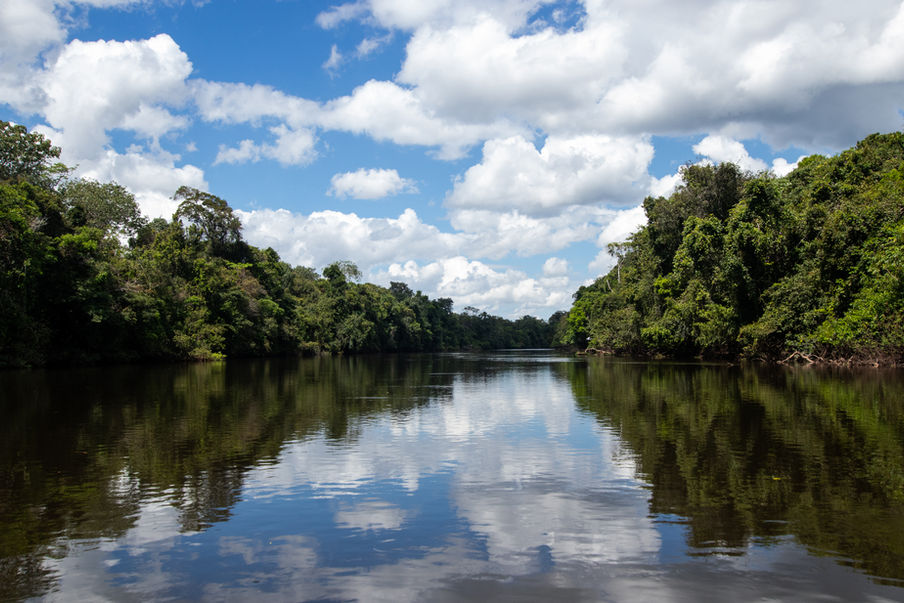.jpg)
.jpg)

Microphotina cristalino is an intriguing species. Only known from two adult males found in our light trap, almost nothing is known about their natural history. This new species, the first one we describe for Amazonia, probably lives in the canopy, which makes us rethink the way we perceive the diversity of the rainforest.
It was found in 2021, during the :Austral expedition, when we spent two months at RPPN Cristalino, south of the biome, in Mato Grosso. Even with intense searches, only the light trap was able to reveal it. Living in the middle of the Arc of Deforestation, the species may even be threatened, but it remains protected by the RPPN and other conservation units and surrounding indigenous lands, leading us to name the species in honor of the reserve that hosted the expedition and of Cristalino river.

RIVERA, HERCULANO, LANNA, CAVALCANTE & TEIXEIRA, 2020
"A new species of Microphotina Beier, 1935 from the southernmost region of Amazonia (Mantodea: Photinaidae)"
%20copiar.jpg)
HEAD
Longer than higher, with red antennae
.jpg)
BODY
Translucent and rather slender, with translucent wings


STYLI
Triangular in shape, almost as wide as long

SUBGENITAL PLATE
With a concave and sharp notch

THE MYSTERY OF THE CANOPY
The description of Microphotina cristalino was based on adult males, found only in our non-lethal light trap. Even in two months of expedition we did not find any individual of the species in the searches in the rainforest. Reviewing the literature, we noticed the same happened for the other four species of the genus Microphotina. In only one of them is the female known, from a single specimen. This means that, apart from flying males attracted to lights, females and juveniles, which do not fly, and oothecae are unknown. Thus, we hypothesize that it is a canopy-dwelling insect, living in the treetops and rarely descending to the lower parts of the forest. And because of that, it may already be threatened. As it lives in the higher areas, the crystalline praying mantis probably depends on preserved forests. Unfortunately, the region is part of the infamous Arc of Deforestation, where devastation is most advanced. The Cerrado-Amazonia ecotone, this region of contact and exchange between the two biomes where the RPPN Cristalino is located, concentrates a very rich and unique biodiversity, but has already lost 40% of its original coverage.
.jpg)
THROUGH THE FORESTS OF BRAZIL
The genus Microphotina, with its five species, is known only from Amazonia. Before our work, it was registered for the North and West portions of the biome, regions where the forest is very humid all year round, and even in the so-called "dry season" there is rain. The crystalline praying mantis extends the distribution of the group to the south of the biome, where there is indeed a dry season, with months without any rain. The forest there is different from the rest of Amazonia. The existence of Microphotina cristalino in such an environment raises an important question: could it be that the lineage has also adapted to other forests, such as stretches of natural forests in the Caatinga and Cerrado, and specially the Atlantic Rainorest? We raised this hypothesis in the article, and months later, before the paper even came out, it was confirmed. This story, however, remains for the next scientific publication.
ART, CONSERVATION AND SCIENCE
The first artistic illustration of the new species already exists - a work commissioned to the amazing Henrique Vieira, visual artist and illustrator. In the thin forms with translucent wings, sailing through the great kingdom of forest canopies, the Amazonian night welcomes the tiny Microphotina cristalino. We must celebrate each new being that we catalog for the planet, remembering the still unknown, threatened and beautiful diversity that coexists with us. Art is one of the most important forms of human expression and connection. From it we can awaken new or renewed perceptions to nature. Henrique's work brings the crystalline praying mantis to the world, inspiring thought and movement towards conservation. Science and art go hand in hand in the quest to reforest places and minds, to resist and occupy with biodiversity. Learn more about Henrique Vieira's work on his Instagram.








